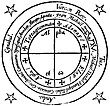
Back Magie chaosu Czech Dewiniaeth Caos Welsh Chaosmagie German Magia del caos Spanish Magie du Chaos French Maxia do caos Galician Քաոսային մոգություն Armenian ケイオスマジック Japanese Chaosmagie Dutch Gwiazda chaosu Polish
| Part of a series on |
| Chaos magic |
|---|
 |
| Part of a series on |
| Magic |
|---|
 |
Chaos magic, also spelled chaos magick,[1][2] is a modern tradition of magic.[3] Emerging in England in the 1970s as part of the wider neo-pagan and esoteric subculture,[4] it drew heavily from the occult beliefs of artist Austin Osman Spare, expressed several decades earlier.[3] It has been characterised as an invented religion,[5] with some commentators drawing similarities between the movement and Discordianism.[6] Magical organizations within this tradition include the Illuminates of Thanateros and Thee Temple ov Psychick Youth.
The founding figures of chaos magic believed that other occult traditions had become too religious in character.[7] They attempted to strip away the symbolic, ritualistic, theological or otherwise ornamental aspects of these occult traditions, to leave behind a set of basic techniques that they believed to be the basis of magic.[8]
Chaos magic teaches that the essence of magic is that perceptions are conditioned by beliefs, and that the world as we perceive it can be changed by deliberately changing those beliefs.[9] Chaos magicians subsequently treat belief as a tool, often creating their own idiosyncratic magical systems and blending such different things as "practical magic, quantum physics, chaos theory, and anarchism."[10]
Scholar Hugh Urban has described chaos magic as a union of traditional occult techniques and applied postmodernism[11] – particularly a postmodernist skepticism concerning the existence or knowability of objective truth.[12] Namely, according to him, chaos magic rejects the existence of absolute truth, and views all occult systems as arbitrary symbol-systems that are only effective because of the belief of the practitioner.[12]
- ^ Carroll (2008).
- ^ Humphries & Vayne (2005), p. 17.
- ^ a b Chryssides (2012), p. 78.
- ^ Woodman (2003), p. 2.
- ^ Cusack & Sutcliffe (2017), p. [page needed].
- ^ Urban (2006), pp. 233–238; Duggan (2014), p. 96.
- ^ Drury (2011), p. 86.
- ^ Drury (2011), p. 86; Hine (2009), p. 15.
- ^ Woodman (2003), p. 15-16, 165, 201.
- ^ Meletiadis (2023), p. 2.
- ^ Clarke (2004), pp. 105–106.
- ^ a b Urban (2006), pp. 240–243.